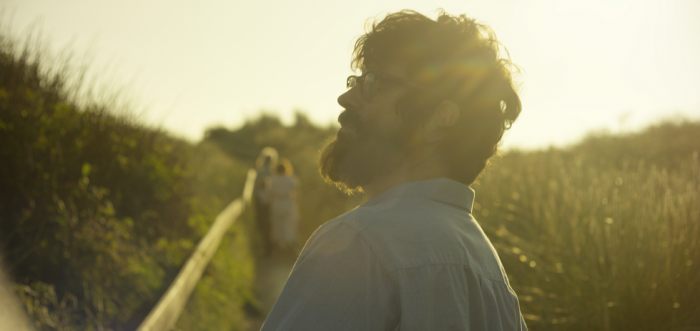
Notes on Blindness, a feature-length adaptation of its makers’ previous SFF short film effort Notes on Blindness: Rainfall, embarks on a bold cinematic project. In a medium that heavily depends on visuality to generate meaning, this captivating hybrid docu-fiction attempts to render the experience of blindness; the unimaginable state of perpetual, imageless dark. It’s a basic paradox which could fall hopelessly flat, but co-writers and -directors Peter Middleton and James Spinney pull it off by expanding on their previous work to retell the story of theologian academic John M. Hull in his own words, with sensitivity, profundity, and an uncanny understanding of human nature. The film’s shortcomings in narrative tone are tempered throughout by its success in plumbing the depths of Hull’s most personal sufferings, by way of mannered, contemplative sound and light design. Its slightness as a short film adapted to feature length is made up for, too, through reflective, languorous pacing which places us squarely within Hull’s mind—or better, in his mind’s eye.
The film is based on an extensive set of audio diaries recorded by its subject-slash-protagonist, an Australian-born eminent University of Birmingham academic who lost his sight in his forties after a lifetime of ocular problems. In them, he initially documented the processes by which he adapted practically to sightlessness, through clever methods of transcribing books for his work and navigating his physical environment. Over time, the diaries began to record his spiritual battles too, as Hull fully comprehended that he would never see his wife Marilyn or children again, or the external world in which his identity had been moulded.
Notes on Blindness, in approaching the task of adapting these hugely emotive recordings for the screen, makes use of a conceit previously employed in its embryonic short: much of the dialogue is delivered by John and Marilyn themselves, either in voiceover or directly via playback of his recordings. Meanwhile, actors (Dan Renton Skinner, also in SFF 2016’s High-Rise, and Simone Kirby) perform a fictive imagining of the scene while lip-syncing the words. Curiously, the scenes depicted often make little chronological sense—for example, we may see the couple at their dinner table in the 1980s in the early stages of John’s blindness, while the voiceover (and consequently, the actors) say things like “yes, I remember how I felt around that time.” This atemporality both jars and rhymes with the rest of the film. On one hand, the film on the whole follows an unspecified but clearly linear narrative timeline from the Hulls’ earlier days to his total blindness after years of deterioration. On the other, irrational boundary-setting between past/fictional and present/real mimics Hull’s stripping-away of his main means of making sense of the world—vision—by depriving the viewer of their main means of understanding film narrative: linear time.
The work’s efforts to render blindness through visual cinematic style are inventive, too. Middleton and Spinney begin from perhaps the obvious position that our third-person view of Hull’s surroundings as he loses his sight should rely on darkness rather than light to express his inner experience. Jarring viewers with contrasts between airy external shots and the pitch-black of Hull’s mind would be a too-easy manifestation of the light/dark dichotomy, however. The directors realise this, and shoot many sequences, especially those where Hull is alone, in half-light that prioritises tiny spots of dappled chiaroscuro on small, intimate items—we are drawn to banal everyday objects like the wooden backs of chairs, glinting sinks, and the lenses of the glasses he almost tragically continues to wear. Honing in on the quotidian aspects of life without sight carries over from the film’s cinematography into its framing and blocking—Middleton and Spinney are bold enough to refuse to allow us to place Hull spatially within a given room or environment. With the camera perpetually focused on either its main character in close-up, or on the mundane aspects of life with which he now struggles, it’s as impossible for viewers to comprehend real physical space as it is for Hull.
The total effect of these stylistic considerations is powerful, bringing into relief the unique but horrible potential for endless introspection forced upon its protagonist by his blindness. While it’s trite for a sighted viewer to claim that the film ‘explains’ or ‘evokes’ the condition of sightlessness, there is a strong sense that Notes on Blindness offers a genuine perspective of the experience, giving Hull-as-narrator agency in defining his own role in the interior world he inhabits. The work does struggle towards its end to fully deal with the deeper philosophical considerations which Hull discusses in his recordings. The sequences which attempt to reconcile his religious faith with his condition are ineffective, with Hull coming off as a hand-waving apologist for the ill-defined mystery of God’s will; a failing which seems unlikely in a leading academic of theology. In the end, though, the filmmakers’ comparative inexperience is hard to believe in a work which so ably melds documentary and fiction to inform, rather than obscure, the depth of its subject matter. Notes on Blindness is one of the more challenging SFF competitors for 2016, and also one of the most thought-provoking.
Around the Staff:
| Peter Walsh |
